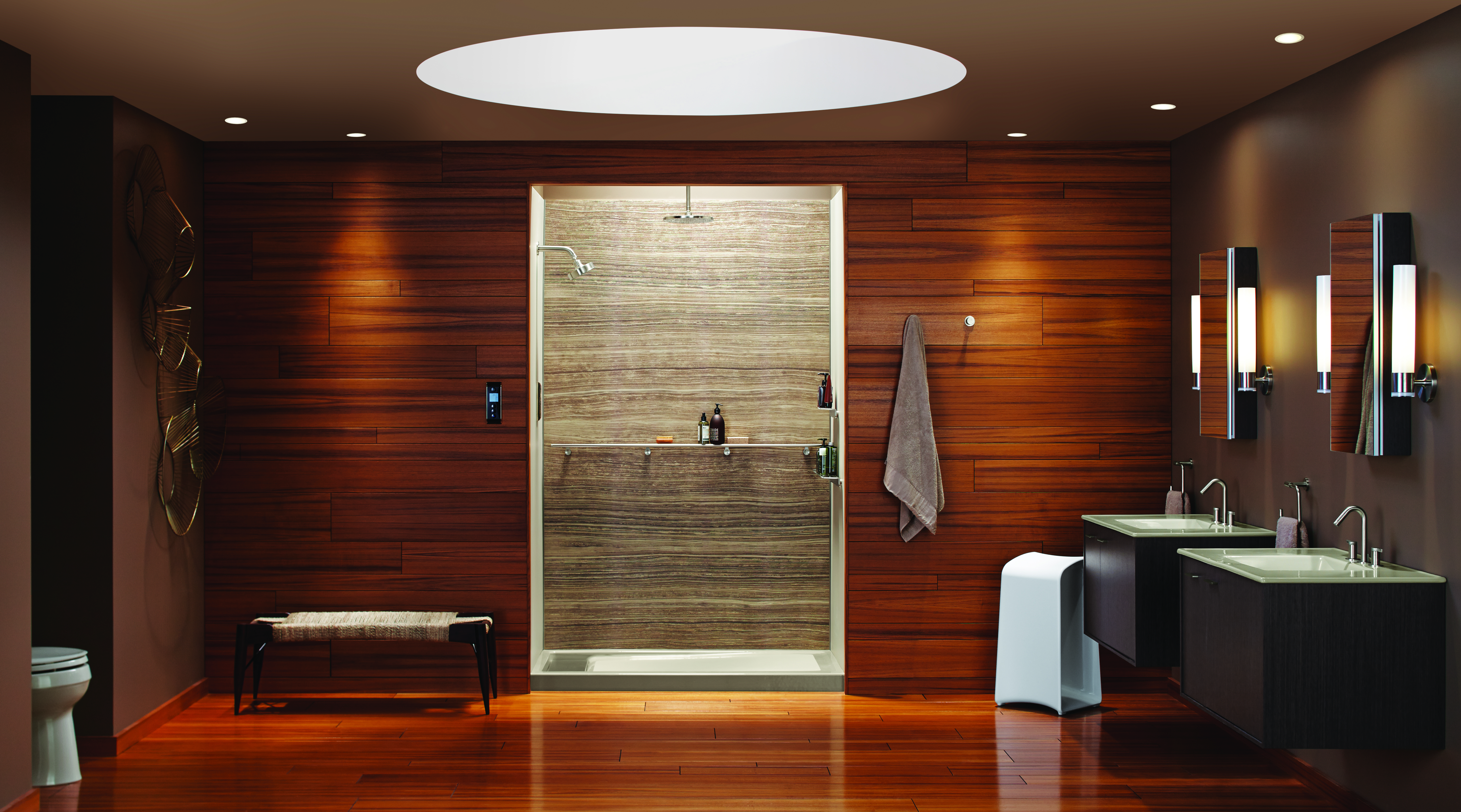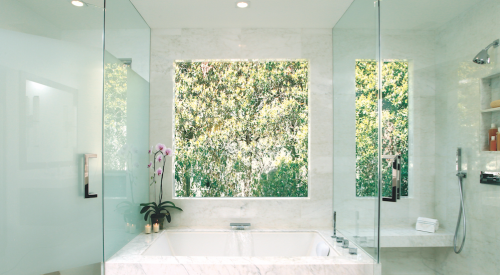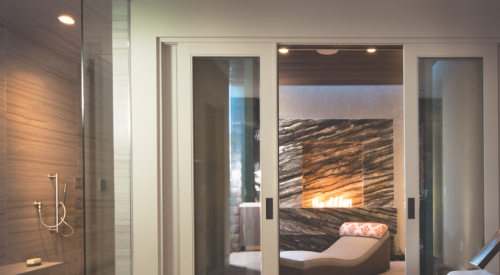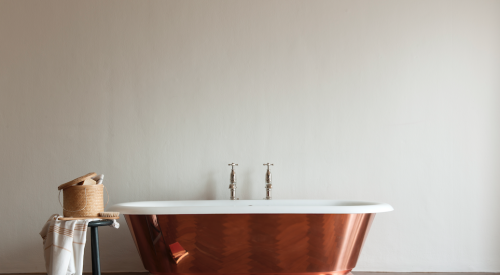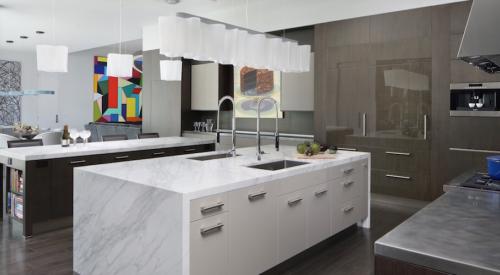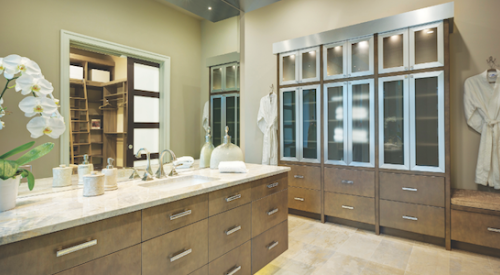The sophistication and quantity of bath products available to designers and builders continues to grow, matched only by the appetites of consumers for more convenience and style in their bathrooms. According to architect Dave Kosco, director of design at Bassenian Lagoni, in Newport Beach, Calif., “Bathrooms today are becoming as much of a showpiece as the kitchen—retreat-like sanctuaries with unique/original finishes and fixtures.” Oversize showers prevail, fully appointed with audio, TV, and multiple showerheads. Bathtubs are trending toward freestanding design elements, rather than the traditional built-in tiled box. On the higher end in particular, generously sized wet rooms with a freestanding tub contained within are making their way into production homes.
Bath functionality is top of mind. “Closets are getting larger and storage is being addressed via linen cabinets inside the bathroom,” Kosco continues. “We are seeing more master bathrooms linked to the upstairs laundry rooms accessed from the walk-in closet.” Manufacturers are responding with products that answer the demand for functional and luxurious baths.
Upping the Ante
“Homebuyers are looking for more in their master bathrooms. More technology, comfort, and space,” says Peter Salerno, owner of Peter Salerno Inc., in Wyckoff and Mendham, N.J. “They want the option to use aromatherapy or chromatherapy as they are enjoying their steam shower,” he adds. “Master bathrooms now have his-and-hers vanities, or go one step further—separate his-and-hers bathrooms.” Timothy Gehman, director of design for Toll Brothers, in Horsham, Pa., adds, “Tile sizes seem to keep increasing as well, even on walls, and natural wood accents are more desired to offset the somewhat commercial feel that the larger tile creates.”
Experts agree that there are more product choices today than there were five to 10 years ago. “It used to be simple smooth ceramic or porcelain tile. Today tiles are offered in many materials from metal and wood to glass, and are textured from smooth to three-dimensional illusions,” Kosco says. “Bathroom lighting has improved, often incorporating pendants, sconces, or chandeliers, as opposed to the old Hollywood strip light or boring ceiling-mounted dome.”
And, of course, technology has been added to many fixtures and fittings to improve performance and multiply the tasks they handle. “Consumers want to be able to take a shower and listen to the music on their smartphone via shower speakers,” Salerno says. “They want their smartphones to have a charging station,” even in the bath. Modern medicine cabinet and vanity models now often incorporate electrical outlets and USB ports.
Christopher Grubb, president of Arch-Interiors Design Group, in Beverly Hills, Calif., says that popular choices among his clients include tubs that enhance the spa experience with Euro-jets and chromatherapy, “intelligent” toilets, and decorative or invisible drain covers.
Gehman clarifies that it’s not that homeowners want many more products in their baths, but they want what suits them in particular—selections that specifically match their lifestyle or desired experience. “From a supply standpoint,” he says, “that equates to more selections, but from an individual-demand standpoint, it’s not perceived as more choices, but rather the right choices.”
Clean Visuals
Regarding the popularity of freestanding tubs, Gehman points out, “I’m sure they get some use, but they’re more desired for their sculptural quality within the space.” Recent research from Home Innovation Research Labs confirms a similar trend. “Vessel sinks, while gaining a lot of attention in home makeover shows, have not gained a lot of traction in bathrooms overall,” says Ed Hudson, Home Innovation’s director of market research. Undermount sinks are now the most popular, usually paired with natural stone countertops.

Bath vanities like this one, from the Adler Vanity Collection by Elements from Hardware Resources, have elegant hardware, on-trend finishes, and come in multiple sizes and configurations.
Grubb emphasizes that homeowners expect the available space in the bathroom to be maximized physically and visually. One major design trend he sees today is “creating as open a feeling as possible with as much natural lighting as possible.” Using cantilevered elements, such as wall-hung toilets and vanities, is one way to make the room feel larger. Those elements, as well as open shelving, made it into the top 10 trends in the NKBA Design Trends Survey.
In spite of homeowners’ desire for amenity-packed bathrooms, they also want the look to be streamlined. Topping the NKBA survey trend list is clean-lined transitional styling, with 70 percent of respondents expecting to specify it in 2016. Salerno agrees that baths today are all about clean lines and simplicity. “The tile, cabinetry, and plumbing fixtures all contribute to create this sleek look,” he says. White and neutral shades, including gray, are the most prevalent colors, along with chrome finishes.

Streamlined drains aren’t just rectangular anymore. The circular DOT drain from ESS has an industrial-style texture and stainless steel finish that add sleekness to barrier-free showers.
For Millennials, Bigger Isn't Better
According to new research from the NKBA reported in July 2016, Millennials outspend other age groups when it comes to remodeling the bathroom, laying out 42.3 percent more than the $11,364 normally allocated. Conducted by The Farnsworth Group, the “Understanding Millennial Kitchen & Bath Consumers” study compares the behavior and attitudes of those aged 18 to 37 to other generations. It found that more than half of the Millennial generation has purchased a home in the past five years.
Grubb has seen the shift to younger clients in his business. “We’re starting to do more as the first-born Millennials are entering their 30s and are making their first home purchases,” he says. “With their exposure to the Internet, Houzz, and Pinterest, they are more involved and participatory with the look and design direction they’d like.”

Designed for smaller spaces, the Evanescence compact freestanding tub from BainUltra measures 59 by 36 by 28 inches. It includes heated backrests and headrests and remote controls. Chromatherapy and warm air jet technology options are also available.
Having been raised with cell phones and computers, Millennials may expect more bath products to integrate technological innovations. “Millennials are about technology and comfort,” Salerno says. “They want a beautiful bathroom with clean lines, little maintenance, [that offers] energy efficiency, smart technology, and, at the same time, is respectful of the environment.”
However, when it comes to size, Kosco notes that personalized options and good looks best square footage. “It comes down to space allocation and the statement that the space makes,” he explains. “Small is OK as long as it functions well and makes a strong impression.” In response to compact homes and apartments, manufacturers are introducing scaled-down options, including soaking tubs.
Being Water-Wise
Now, a plethora of products pair attractive design with energy- and water- saving, from LED lighting fixtures to low-flow toilets. Government regulations and programs have also led to more eco-friendly options. WaterSense, a partnership program from the U.S. Environmental Protection Agency, certifies products to be at least 20 percent more efficient without sacrificing performance. But Kosco believes that buyers are no longer swayed by shouting out water savings. “We’ve reached the point where buyers expect it—and that’s a difference from five to 10 years ago,” he says.
California leads the country in standards for water- and energy-conservation, yet the demand for a spa experience requires more water. In drought-ridden states such as California, codes have changed; it’s necessary to complete reports with plans indicating that new homes fulfill a green checklist. Manufacturers have responded to the demands posed by the California codes. Tankless water heaters and LED lighting have made big advances.

StyleFlow Air showerheads and handheld showers by California Faucets are offered in flow rates from 2.5 gallons per minute (gpm) to ultra-low 1.5 gpm, saving water by infusing air into the water droplets for a robust showering experience.
Yet Gehman thinks there’s a limit to how far the eco-friendly movement will advance into the bath. “There’s still too great a disconnect between the cost of eco-friendly materials and features and buyers’ expectations of what those costs should be,” he explains. “When push comes to shove, they’re opting for less-expensive alternatives, which tells me that the desire is being driven by a ‘citizen of the world’ wish, rather than any long-run cost analysis. Should the cost and availability of green materials fall more into line with traditional choices, I think you’ll see more folks make the ‘good’ choice.”
Boomer Concerns
Builders, architects, and designers see the need to create baths that will be safe for an aging America. For Salerno, universal design should be central to bath products and design. “Baby Boomers are either downsizing or redesigning their homes to address their changing needs,” he says. “The bathrooms are the areas that need the most attention. Is the door wide enough for a walker or a wheelchair? Is there enough room in the shower for a seat or bench? Does the shower have a curb? Are there grab bars by the toilet, shower, and bathtub? All these questions need to be answered by the designers and builders. All homes should be designed with safety and comfort in mind.”
But a push toward universal design isn’t just driven by Boomers worried about their own future. It also reflects the increase in multigenerational households. “Boomers often design with aging parents in mind, who may join the household when they are less able to care for themselves,” Hudson says.
Grubb notes that clients want designs they can age into. He’s aware of the growing necessity for zero-threshold showers, strongly secured towel bars that double as grab bars, shower benches set for easy maneuverability, hand-held showerheads that are simple to reach, and niches positioned in lower locations. Good lighting, ergonomically smart handles, and nonslip surfaces need to be integrated into the whole design, as do increased clearances at doors and around toilets; comfort-height vanities and toilets, sinks, and tubs—common design considerations in age-qualified communities. But in spite of the increasingly handsome array of universal design products available, there’s still denial on the part of buyers regarding the need for them. “Many people see these features as less desirable,” Gehman says. “Maybe it’s too much of a reminder of their own mortality, or at least pending frailty.” PB
Wanda Jankowski, a writer based in New York, covers products and architectural design. She has written several books on design.
BATHS: THE MOST POPULAR MUST-HAVES
Any features that offer easy maintenance are gaining popularity, but here are the amenities most frequently specified by respondents in the 2016 Design Trends Survey conducted by the National Kitchen & Bath Association (NKBA):
– Electric radiant floor heating
– One-piece toilets
– Electric towel warmers
– Humidity-sensing fans
– Steam showers
– Smart toilet seats with integrated bidet features
– Shower lighting
– Handheld showerheads
For a slideshow of more bath products, click on the image below.
